You ever open your fridge, stare at the door full of sauces, and think… they all kinda taste the same? Then you meet hoisin sauce — and suddenly nothing’s the same again.
It’s sweet. It’s savory. It’s sticky in a way that makes chicken thighs glossy and veggies disappear from picky plates. And once you try it, there’s no going back.
But what is hoisin sauce really? What’s inside that bottle? How do you use it without messing things up? And what if you run out right when you’re halfway through a stir-fry?
We’re diving deep into this flavorful sauce — not just how it tastes, but what’s in it, how to swap it, and why it might be the most underrated bottle in your kitchen.
What Is Hoisin Sauce?
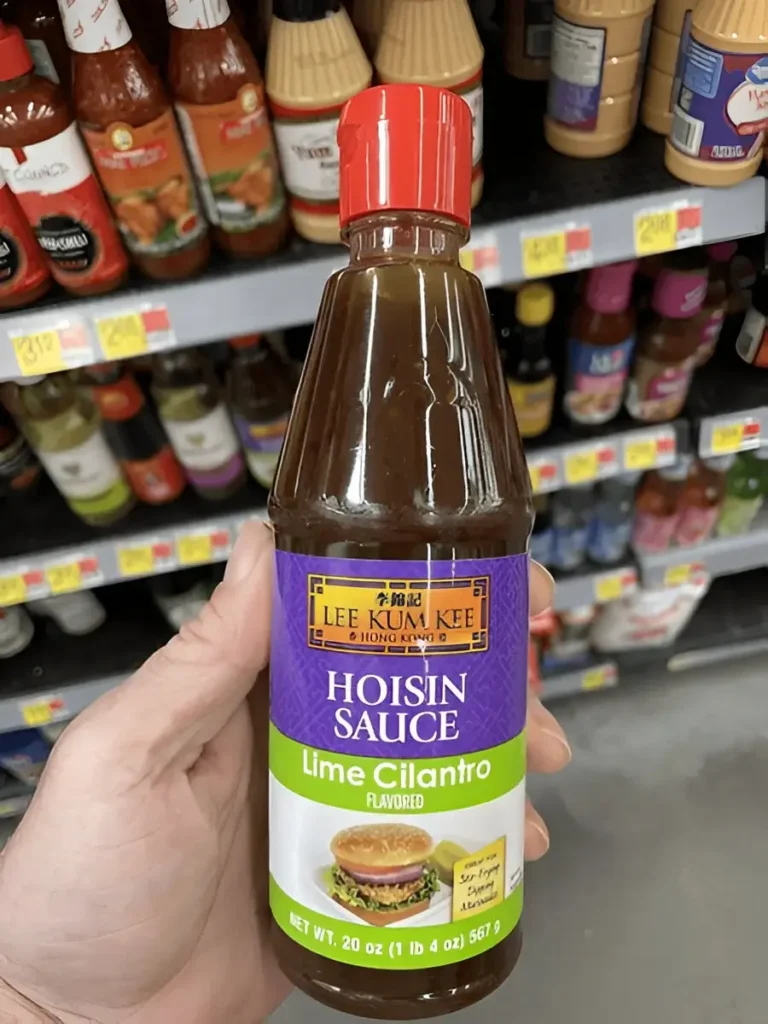
Think of hoisin sauce as the flavor bridge between sweet and savory. It’s a classic staple in Chinese cuisine, especially in Cantonese cooking, where it’s used in everything from roasted duck to dipping sauces for spring rolls.
It’s thick like barbecue sauce but has way more going on — soybean paste, garlic, sugar, vinegar, and a handful of spices that make each spoonful hit just right. It’s bold, no doubt, but not overpowering.
Some folks call it “Chinese BBQ sauce,” but honestly? That sells it short.
This sauce isn’t trying to imitate American barbecue. It’s doing its own thing, rooted in fermentation, balance, and depth.
Hoisin Sauce

Hoisin Sauce Ingredients
You ever read the label on a jar and feel like you’re decoding a secret recipe? Let’s break it down in plain language. The ingredients in hoisin sauce usually include:
- Fermented soybeans – That’s where the real umami flavor comes from. Deep, salty, complex.
- Sugar – It brings sweetness, but not in a candy way. Think brown sugar meets molasses.
- Garlic – Adds a little bite and keeps the flavor grounded.
- Rice vinegar – Tiny bit of acidity to balance all that sweet and savory.
- Five-spice powder – This spice blend might include cloves, star anise, cinnamon, fennel, and Sichuan peppercorn. Warm, aromatic, just the right amount of exotic.
- Chili peppers – Usually not spicy-hot. Just enough warmth to round it out.
- Starch or wheat flour – To give it that signature thickness.
Now, not every brand sticks to the same formula. Some use miso paste instead of whole soybeans. Others toss in extra garlic or sesame oil. But the soul of hoisin? It’s always that fermented-sweet-salty balance.
What Hoisin Sauce Tastes Like (And Why It’s Addictive)
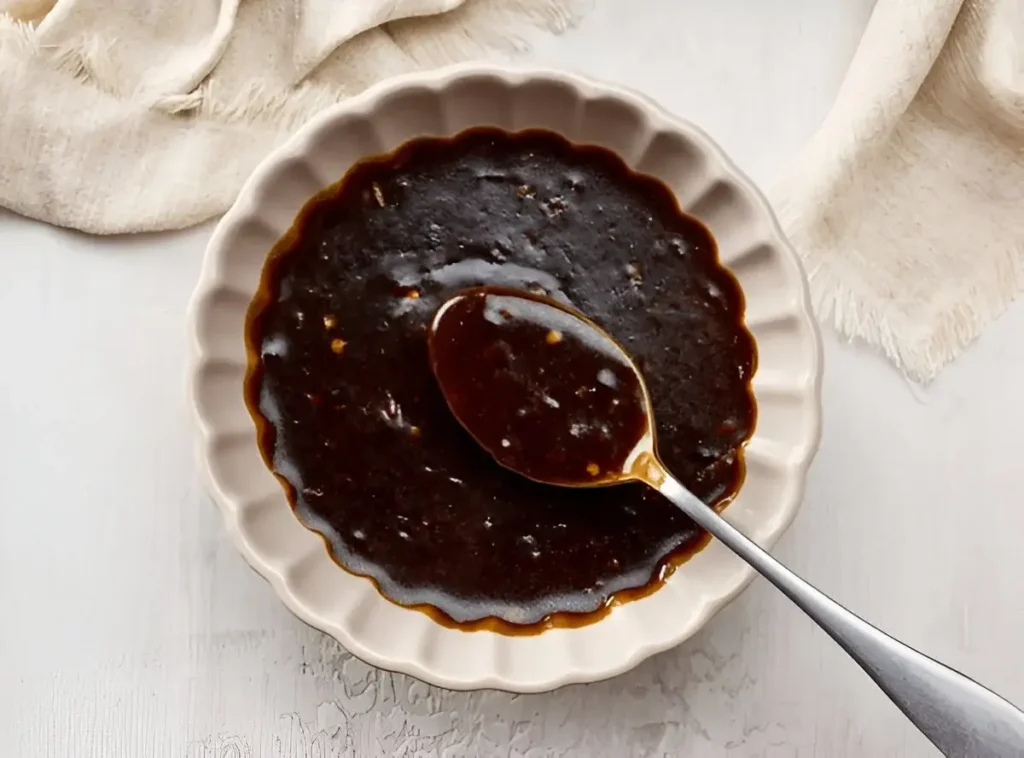
Let’s say you’ve never tasted hoisin sauce before. Here’s what to expect.
It’s thick, like honey or molasses. When you open the bottle, you’ll get a hit of something sweet… but also savory. One spoonful and you’ll notice layers — sweetness first, then a deep soy flavor, followed by garlic and spice on the back of your tongue.
It’s not spicy, and it’s not sour either. Just warm, bold, and balanced.
You know that glossy coating on Chinese BBQ ribs or that magical dip for Peking duck? Yeah. That’s hoisin doing what it does best.
And because it’s so packed with flavor, you don’t need much. A spoon or two will transform a dish.
All the Ways You Can Use Hoisin Sauce
This stuff is versatile. Once you open the bottle, it’ll start showing up in all your cooking. Not because you planned to — just because it works.
Here’s where hoisin sauce really shines:
As a marinade: Mix it with garlic, a bit of soy sauce, and something acidic like lime juice or vinegar. Let meat soak it in — especially chicken or beef.
For stir-fries: Add a spoon or two to noodles or veggies right before serving. It clings to ingredients and gives that takeout-style flavor instantly.
As a dipping sauce: Pair it with dumplings, rolls, roasted veggies, even French fries if you’re feeling wild. Sometimes folks mix it with sriracha or peanut butter for an even deeper flavor.
In glazes: Brush it over ribs, tofu, or skewers in the last few minutes of roasting or grilling. It caramelizes beautifully.
With pho: Hoisin and a dash of chili sauce are often served on the side with a big bowl of pho. Drizzle it over your noodles or dip your meat — either way, it’s part of the ritual.
You don’t need to follow a recipe. Just let it guide your cooking the way a little salt or lemon might. Taste, adjust, repeat.
Hoisin Sauce Substitute
So let’s say you’re halfway through cooking and realize your hoisin bottle is empty. Yep, happens to all of us. The good news? You’ve got options.
There’s no one perfect hoisin sauce substitute, but there are a few combos that come close — especially in flavor and texture.
Try one of these:
- Soy sauce + peanut butter + honey: This one’s a crowd favorite. Creamy, salty, sweet, and thick. Add a little rice vinegar or garlic to round it out.
- Miso paste + brown sugar + garlic: Miso brings that fermented funk like hoisin. Add sweetness and a touch of soy sauce and you’re good.
- Plum sauce + soy sauce: Plum sauce is already sweet and sticky. Mix with soy and you’ve got a close cousin.
- Black bean paste + sugar + vinegar: A bit more savory than hoisin, but it scratches the same itch. Add sesame oil for bonus flavor.
- BBQ sauce (in a pinch): Is it the same? Not quite. But if you’re glazing meat or roasting something, it’ll do in a crisis.
The trick is to balance sweet, salty, and savory — and go easy. You can always add more.
Can You Make Hoisin Sauce at Home?
You can, and it’s easier than you’d think. The store-bought kind has its charm, but homemade hoisin? You get to control the sweetness, texture, and ingredients.
Here’s a simple DIY hoisin sauce recipe that hits all the right notes.
Hoisin Sauce Recipe
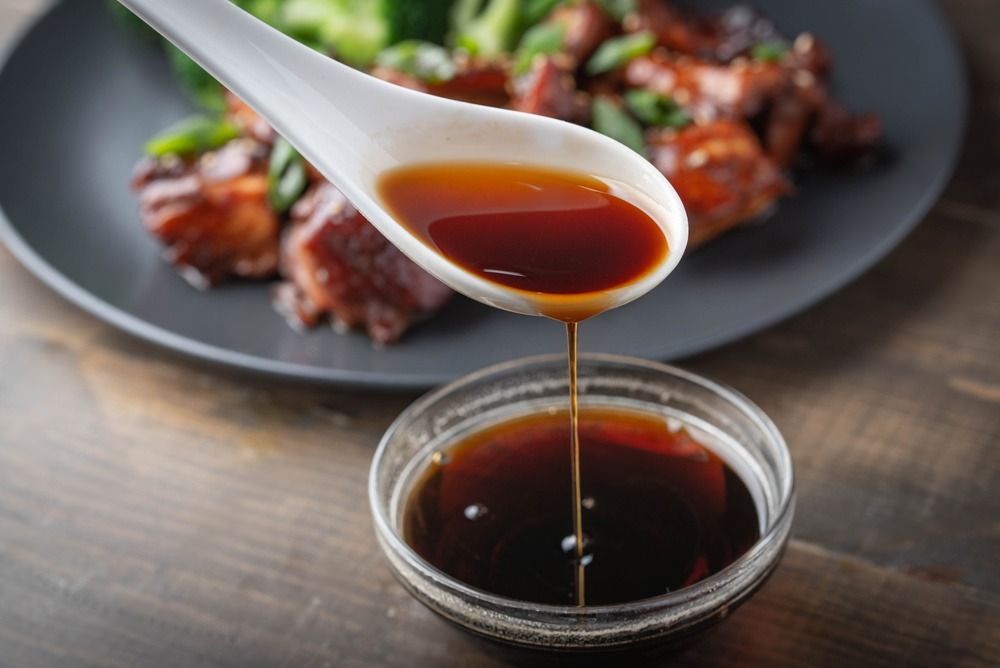
Ingredients
- 4 spoons of smooth peanut butter (or black bean paste if you want it closer to the traditional flavor)
- 2 spoons soy sauce
- 1 spoon of honey or molasses
- ½ a spoon of rice vinegar
- ½ a clove of fresh garlic (grated)
- A pinch of five-spice powder
- Optional: A drop or two of sesame oil
- Optional: A dab of hot sauce or chili paste if you like a little kick
Instructions
Mix it all in a bowl until smooth. Add warm water if it feels too thick. Taste, adjust, and let it sit for a few minutes before using. You just made your own hoisin sauce without weird preservatives or fillers.
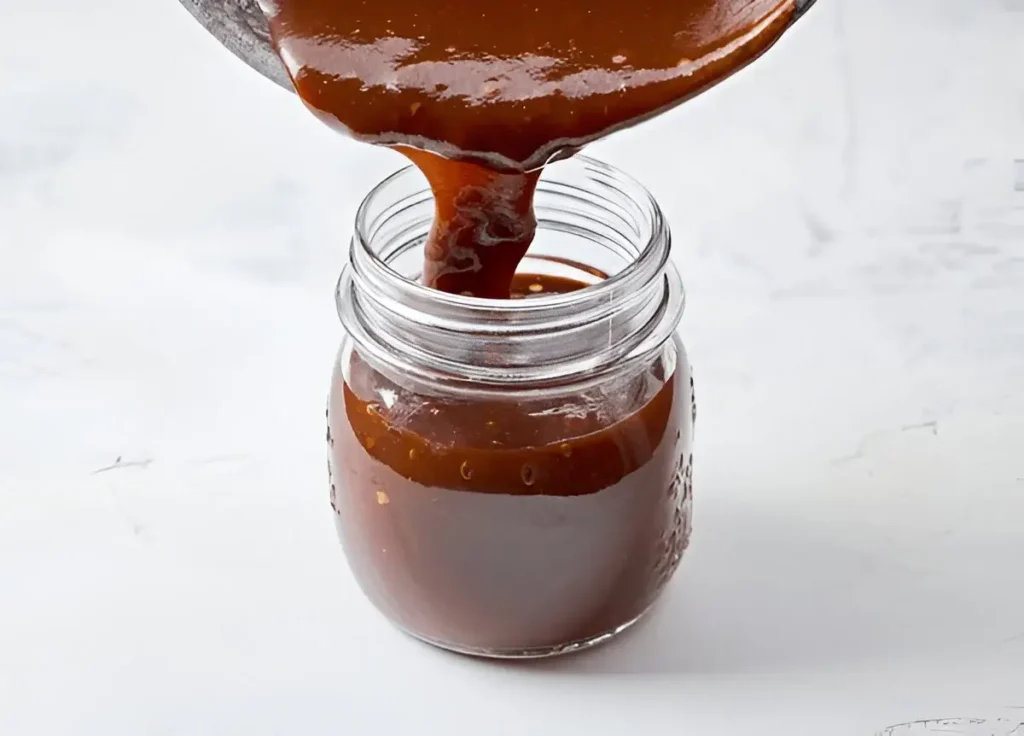
Best Hoisin Sauce Brands to Try
Not all bottles of hoisin are built the same. Some are heavy on the sugar. Others lean into spice or soy. So which one should you trust?
Here’s a shortlist of hoisin sauce brands that people (and pro chefs) keep coming back to.
Lee Kum Kee
The classic. Widely available. Thick, balanced, and very sweet. If you’ve had hoisin at a Chinese restaurant, there’s a good chance it was this one.
Koon Chun
Less sweet, more savory. Ideal for folks who want the fermented flavor to shine. Great for marinades and cooking.
San-J Gluten-Free Hoisin
If you’re avoiding gluten or want a vegan version, this one gets high marks. It’s a little thinner than others, but still full of depth.
Annie Chun’s
Lighter, slightly tangier. More of a modern spin on hoisin. Great for folks new to the sauce.
Each one has its own flavor profile, so if you’re a first-timer, try a couple. Taste them plain. Use them in different dishes. You’ll quickly find a favorite.
How to Store Hoisin Sauce
- Unopened: Store in a cool, dark pantry
- Opened: Keep refrigerated; lasts up to 6–8 months
- Signs of spoilage: Mold, sour smell, color changes
Always use clean utensils to avoid contamination.
Is Hoisin Sauce Healthy?
Hoisin sauce is flavorful, but it’s not a superfood. That said, it’s not a villain either.
What’s in a typical serving?
- Low in fat
- Moderate calories (depends on sugar content)
- Can be high in sodium (watch labels if you’re salt-sensitive)
- Usually gluten-based (check for wheat if you’re avoiding it)
So is it healthy? It’s fine in moderation. A spoon in a stir-fry here or there is way better than drowning your dish in sugar-laden ketchup or creamy dressings.
If you’re making it from scratch, you can cut the sugar and use gluten-free soy sauce to make it fit your needs.
Quick Comparison: Hoisin vs Other Sauces
Sometimes it helps to see how hoisin sauce stacks up against other flavor powerhouses.
| Sauce | Flavor | Texture | Use Case | Notes |
|---|---|---|---|---|
| Hoisin Sauce | Sweet, savory, rich | Thick, sticky | Stir-fries, dips, marinades | Contains fermented soy |
| Soy Sauce | Salty, umami | Thin, liquid | Base seasoning, soup, sauces | Pure salt + soy flavor |
| Oyster Sauce | Deep, earthy, slightly sweet | Glossy, syrupy | Stir-fries, greens, beef | Not vegetarian |
| Teriyaki Sauce | Sweet, slightly tangy | Smooth, runny | Grilled meats, glazes | Japanese origin, often lighter |
| Plum Sauce | Fruity, sweet | Sticky, jam-like | Duck, spring rolls | Sweeter than hoisin |
So yeah — hoisin sits in its own lane. Sweet but not fruity. Savory but not just salty. A flavor bomb with balance.
Hoisin Sauce Nutrition and Calories
Here’s the typical nutrition per tablespoon:
| Nutrient | Amount |
|---|---|
| Calories | 35–60 |
| Sugar | 4–7g |
| Sodium | 250–400mg |
| Fat | 0g |
| Carbohydrates | 6–9g |
Always check labels. Homemade versions can reduce sugar or sodium.
What Hoisin and Wassail Have in Common
Now, you’re probably thinking… what does wassail, that warm holiday drink, have to do with hoisin sauce?
Surprisingly, more than you’d expect.
Wassail is spiced cider, often filled with warm, sweet notes — cinnamon, cloves, star anise. Sound familiar?
Those same spices show up in hoisin, especially in the five-spice powder. So while one’s a cozy drink you sip by a fireplace and the other’s a glaze for grilled duck, they speak the same flavor language. Warming spices. Bold base. Sweetness balanced with bite.
Next time you stir hoisin into a dish and catch a whiff of something vaguely holiday-ish… now you know why.
FAQ Time: Everything You’ve Been Wondering About Hoisin
Can I use hoisin sauce instead of oyster sauce?
Sorta. They’re both savory, but oyster sauce is saltier and earthier. Hoisin is sweeter and thicker. If you’re in a pinch, you can swap, but adjust for sweetness.
Is hoisin sauce vegan?
Most store-bought hoisin sauces are vegan, but some contain animal-based colorings or flavorings. Always check the label. San-J and some homemade versions are 100% plant-based.
Does hoisin sauce contain gluten?
Usually, yes. It’s often made with wheat flour or regular soy sauce. But gluten-free versions do exist, so look out for brands like San-J or Kikkoman GF.
How long does hoisin sauce last?
An opened bottle stays good in the fridge for months — just keep the cap clean and sealed tight. Homemade versions last about a week or two.
Can I use hoisin in non-Asian recipes?
Absolutely. Mix it into burgers, toss it on roasted veggies, drizzle on flatbread, stir into chili. It’s your kitchen.
Final Thoughts: Why Hoisin Sauce Deserves a Spot in Your Fridge
Hoisin sauce isn’t just another jar of sticky brown stuff. It’s a flavor booster, a meal saver, a quick fix for boring food. Whether you’re brushing it on ribs, mixing it into noodles, or making a hoisin-style dipping sauce for your Friday night rolls — it brings big taste with very little effort.
And once you know how to swap it, make it, tweak it, and use it creatively? It becomes less of a condiment and more of a secret weapon.
So yeah. Hoisin sauce. Keep it stocked. Keep it in reach. And don’t be afraid to experiment.
You might just wonder how you ever cooked without it.
Print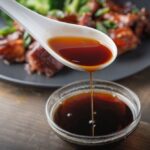
Hoisin Sauce Recipe
Ingredients
- 4 spoons of smooth peanut butter (or black bean paste if you want it closer to the traditional flavor)
- 2 spoons soy sauce
- 1 spoon of honey or molasses
- ½ a spoon of rice vinegar
- ½ a clove of fresh garlic (grated)
- A pinch of five-spice powder
- Optional: A drop or two of sesame oil
- Optional: A dab of hot sauce or chili paste if you like a little kick
Instructions
Mix it all in a bowl until smooth. Add warm water if it feels too thick. Taste, adjust, and let it sit for a few minutes before using. You just made your own hoisin sauce without weird preservatives or fillers.

